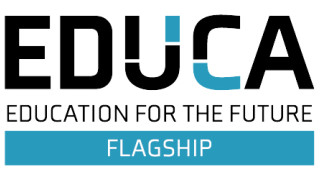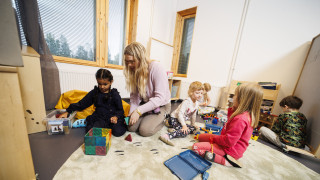Population change is already visible in the everyday life of schools – what does the future of basic education and equality in learning look like?

According to population forecasts, Finland’s total population will begin to decline during the 2030s, but the number of children is already decreasing significantly due to falling birth rates. The differences between municipalities and regions are considerable. In about one in three municipalities, the population is projected to decrease by more than 20 percent over the next decade. By contrast, the population in the Helsinki capital region and other major cities is expected to grow.
Increasingly differentiated demographic trends affect the conditions for organising basic education in municipalities in many ways. The decline in the number of children as well as the financial challenges faced by municipalities have already led to a reduction in the school network, especially in remote and smaller municipalities. Some of these municipalities also face specific challenges, such as organising school transport and ensuring a sufficient level of educational offering.
At the same time, the number of children speaking a foreign language as a mother tongue is increasing in the largest cities. At the end of last year, nearly 11 percent of Finland’s population were foreign-language speakers, and this figure is expected to continue to grow. In these municipalities, the main challenges include meeting the increasingly diverse needs of students and addressing the segregation of residential areas.
Multimethod research report
The report Perusopetuksen tilannekuva erilaistuvissa kunnissa (The state of basic education in diversifying municipalities), commissioned by the Ministry of Education and Culture and published by the Finnish Institute for Educational Research at the University of Jyväskylä, utilises both existing data as well as data collected during the project through a multimethod approach. The survey questions of the report were sent to the officials responsible for education in all municipalities in mainland Finland (293 in total), of whom 158 (53%) responded.
The main issues highlighted in the organisation of basic education included funding, collaboration opportunities between municipalities, teacher recruitment, teaching hours and educational provision, as well as the use of assessment and research data by education providers to support development.
Increase in per-pupil costs
Rural municipalities had the highest operating costs per pupil, which increased between 2017 and 2023 at an average rate that exceeded inflation.
“Operating costs per pupil have increased by an average of 29 percent across all types of municipal groups,” says Jukka-Pekka Jänkälä from the Research Foundation for Studies and Education Otus. “However, in rural municipalities, the cost of basic education has increased more in actual euro amounts than in more densely populated areas with higher numbers of children.”
The higher costs were partly due to school transport, which covered on average 40 percent of pupils in rural municipalities and accounted for about one tenth of the operating costs per pupil.
Funding system discourages collaboration between municipalities
About half of the municipalities that responded already collaborate across municipal boundaries in basic education. In most cases, cooperation was carried out for financial reasons, to improve the quality of education in, for example, special education, and to ensure teaching was provided in line with national curriculum requirements.
However, the current funding system was not considered to encourage collaboration across municipal boundaries.
“Collaboration was seen as possible in principle, but the responses highlighted the need for a better and more transparent funding model and, for example, earmarked funding to initiate and develop collaboration,” says Research Professor Taina Saarinen from the Finnish Institute for Educational Research at the University of Jyväskylä. “The current funding system was not seen to enable financial compensation to municipalities based on actual costs.”
“There has been a need in smaller schools to organise teachers’ duties flexibly, for example, by combining teaching across different educational levels with management responsibilities,” says Professor Mirja Tarnanen from the Department of Teacher Education at the University of Jyväskylä. “As a result, demand is growing for versatile qualifications and more mobility in teaching positions.
“Multiple qualifications, such as combining teaching and management, would support the efficient use of resources.”
Distance teaching still limited
About one in four municipalities utilises distance teaching, mainly in special situations such as teaching religion or rare languages.
According to the survey results, various practical, pedagogical, and technical challenges remain in the broader implementation of distance teaching.
“There are many challenges related to practical arrangements and pedagogical implementation, such as how to address the needs of students in both distance and contact teaching simultaneously,” says Professor Päivi Häkkinen, whose work focuses on the use of technologies for learning at the University of Jyväskylä. “Teaching staff clearly require training and support if distance learning is to be expanded.”
The report was prepared by the Finnish Institute for Educational Research (KTL) and the Faculty of Education and Psychology of the University of Jyväskylä, in cooperation with the Research Foundation for Studies and Education Otus. The research is part of the Education for the Future (EDUCA) Flagship consortium, funded by the Research Council of Finland, which aims to promote the development of education through research-based knowledge and support data-driven management.
Full report
Kalalahti, M., Minkkinen, L., Saarinen, T., Tyni, K., Vaara, E., Ala-Vähälä, T., Häkkinen, P., Jänkälä, J-P., Pitkänen, H., Pöysä-Tarhonen, J., Tarnanen, M. (2025). Perusopetuksen tilannekuva erilaistuvissa kunnissa: Manner-Suomen kuntien tarkastelu (The state of basic education in diversifying municipalities: An overview of municipalities in mainland Finland). The University of Jyväskylä. https://doi.org/10.17011/ktl-rt/16
The report "Perusopetuksen tilannekuva erilaistuvissa kunnissa: Manner-Suomen kuntien tarkastelu" (The state of basic education in diversifying municipalities: An overview of municipalities in mainland Finland) has been commissioned by the Ministry of Education and Culture. It is based on the Ministry of Education and Culture’s preparations launched in spring 2024 for a proposal to address the challenges that demographic developments pose for the organisation of basic education. It supports the work of a dedicated working group, established to develop a strategic vision for the future direction of basic education and to strengthen the realisation of children’s rights.






